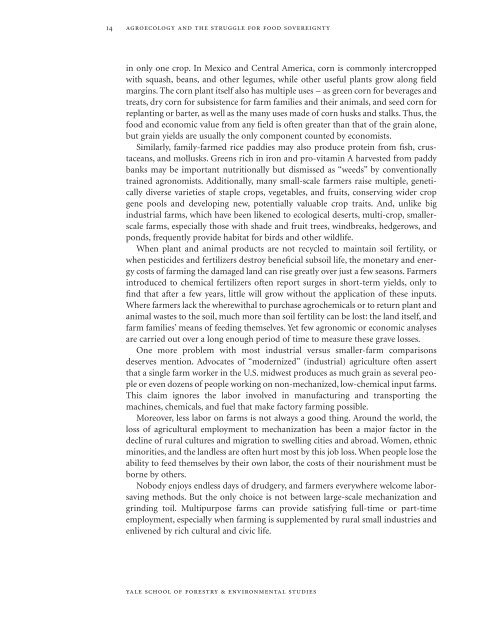Agroecology and the Struggle for Food Sovereignty ... - Yale University
Agroecology and the Struggle for Food Sovereignty ... - Yale University
Agroecology and the Struggle for Food Sovereignty ... - Yale University
You also want an ePaper? Increase the reach of your titles
YUMPU automatically turns print PDFs into web optimized ePapers that Google loves.
14<br />
agroecology <strong>and</strong> <strong>the</strong> struggle <strong>for</strong> food sovereignty<br />
in only one crop. In Mexico <strong>and</strong> Central America, corn is commonly intercropped<br />
with squash, beans, <strong>and</strong> o<strong>the</strong>r legumes, while o<strong>the</strong>r useful plants grow along field<br />
margins. The corn plant itself also has multiple uses – as green corn <strong>for</strong> beverages <strong>and</strong><br />
treats, dry corn <strong>for</strong> subsistence <strong>for</strong> farm families <strong>and</strong> <strong>the</strong>ir animals, <strong>and</strong> seed corn <strong>for</strong><br />
replanting or barter, as well as <strong>the</strong> many uses made of corn husks <strong>and</strong> stalks. Thus, <strong>the</strong><br />
food <strong>and</strong> economic value from any field is often greater than that of <strong>the</strong> grain alone,<br />
but grain yields are usually <strong>the</strong> only component counted by economists.<br />
Similarly, family-farmed rice paddies may also produce protein from fish, crustaceans,<br />
<strong>and</strong> mollusks. Greens rich in iron <strong>and</strong> pro-vitamin A harvested from paddy<br />
banks may be important nutritionally but dismissed as “weeds” by conventionally<br />
trained agronomists. Additionally, many small-scale farmers raise multiple, genetically<br />
diverse varieties of staple crops, vegetables, <strong>and</strong> fruits, conserving wider crop<br />
gene pools <strong>and</strong> developing new, potentially valuable crop traits. And, unlike big<br />
industrial farms, which have been likened to ecological deserts, multi-crop, smallerscale<br />
farms, especially those with shade <strong>and</strong> fruit trees, windbreaks, hedgerows, <strong>and</strong><br />
ponds, frequently provide habitat <strong>for</strong> birds <strong>and</strong> o<strong>the</strong>r wildlife.<br />
When plant <strong>and</strong> animal products are not recycled to maintain soil fertility, or<br />
when pesticides <strong>and</strong> fertilizers destroy beneficial subsoil life, <strong>the</strong> monetary <strong>and</strong> energy<br />
costs of farming <strong>the</strong> damaged l<strong>and</strong> can rise greatly over just a few seasons. Farmers<br />
introduced to chemical fertilizers often report surges in short-term yields, only to<br />
find that after a few years, little will grow without <strong>the</strong> application of <strong>the</strong>se inputs.<br />
Where farmers lack <strong>the</strong> wherewithal to purchase agrochemicals or to return plant <strong>and</strong><br />
animal wastes to <strong>the</strong> soil, much more than soil fertility can be lost: <strong>the</strong> l<strong>and</strong> itself, <strong>and</strong><br />
farm families’ means of feeding <strong>the</strong>mselves. Yet few agronomic or economic analyses<br />
are carried out over a long enough period of time to measure <strong>the</strong>se grave losses.<br />
One more problem with most industrial versus smaller-farm comparisons<br />
deserves mention. Advocates of “modernized” (industrial) agriculture often assert<br />
that a single farm worker in <strong>the</strong> U.S. midwest produces as much grain as several people<br />
or even dozens of people working on non-mechanized, low-chemical input farms.<br />
This claim ignores <strong>the</strong> labor involved in manufacturing <strong>and</strong> transporting <strong>the</strong><br />
machines, chemicals, <strong>and</strong> fuel that make factory farming possible.<br />
Moreover, less labor on farms is not always a good thing. Around <strong>the</strong> world, <strong>the</strong><br />
loss of agricultural employment to mechanization has been a major factor in <strong>the</strong><br />
decline of rural cultures <strong>and</strong> migration to swelling cities <strong>and</strong> abroad. Women, ethnic<br />
minorities, <strong>and</strong> <strong>the</strong> l<strong>and</strong>less are often hurt most by this job loss. When people lose <strong>the</strong><br />
ability to feed <strong>the</strong>mselves by <strong>the</strong>ir own labor, <strong>the</strong> costs of <strong>the</strong>ir nourishment must be<br />
borne by o<strong>the</strong>rs.<br />
Nobody enjoys endless days of drudgery, <strong>and</strong> farmers everywhere welcome laborsaving<br />
methods. But <strong>the</strong> only choice is not between large-scale mechanization <strong>and</strong><br />
grinding toil. Multipurpose farms can provide satisfying full-time or part-time<br />
employment, especially when farming is supplemented by rural small industries <strong>and</strong><br />
enlivened by rich cultural <strong>and</strong> civic life.<br />
yale school of <strong>for</strong>estry & environmental studies

















